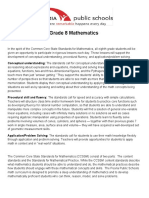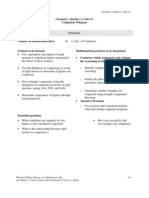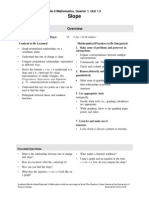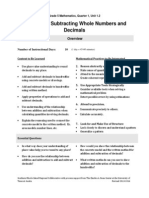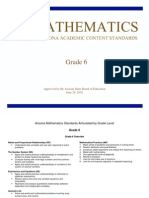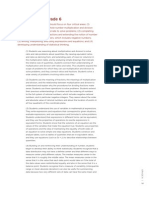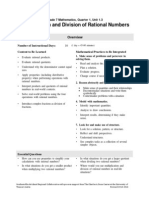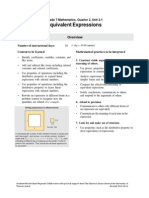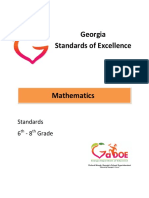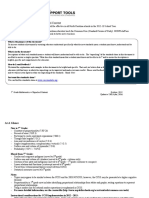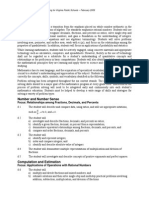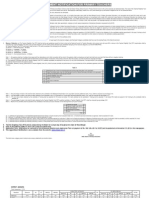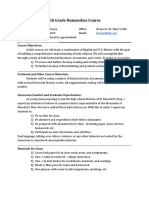Geo 1 4
Geo 1 4
Uploaded by
rmullen82Copyright:
Available Formats
Geo 1 4
Geo 1 4
Uploaded by
rmullen82Original Title
Copyright
Available Formats
Share this document
Did you find this document useful?
Is this content inappropriate?
Copyright:
Available Formats
Geo 1 4
Geo 1 4
Uploaded by
rmullen82Copyright:
Available Formats
Geometry, Quarter 1, Unit 1.
Coordinate Plane Geometry
Overview Number of instructional days: Content to be learned
Use coordinates to prove simple geometric theorems algebraically. Prove the slope criteria and solve geometric problems by using slopes to determine/justify if lines are parallel or perpendicular. Compute perimeter and area in the coordinate plane for geometric figures using the distance formula and Pythagorean Theorem when applicable.
(1 day = 45 minutes)
Mathematical practices to be integrated
Make sense of problems and persevere in solving them. Analyze a problem and use slope and distance formula to solve the problem. Determine when to use a particular formula to solve a problem.
Reason abstractly and quantitatively. Prove theorems using the coordinate plane. Apply geometric properties to coordinate plane proofs.
Construct viable arguments and critique the reasoning of others. Make conjectures based on slope, distance formula, and midpoint. Construct arguments as to when and why equations are used in coordinate proofs.
Model with mathematics. Use the distance formula to determine segment lengths and apply to perimeter and area problems.
Essential questions
What is the significance of slope as it relates to geometric figures in the coordinate plane? How is the coordinate plane useful in proving geometric theorems? Why is it important to be able to prove geometric properties to solve problems rather than simply apply properties? What strategies can you employ to find perimeter and area of figures in the coordinate plane?
Warwick Public Schools, in collaboration with the Charles A. Dana Center at the University of Texas at Austin
C-13
Geometry, Quarter 1, Unit 1.4 2011-2012
Coordinate Plane Geometry (8 days)
Written Curriculum
Common Core State Standards for Mathematical Content
Geometry
Expressing Geometric Properties with Equations G-GPE
Use coordinates to prove simple geometric theorems algebraically [Include distance formula; relate to Pythagorean theorem] G-GPE.4 Use coordinates to prove simple geometric theorems algebraically. For example, prove or disprove that a figure defined by four given points in the coordinate plane is a rectangle; prove or disprove that the point (1, 3) lies on the circle centered at the origin and containing the point (0, 2). G-GPE.5 Prove the slope criteria for parallel and perpendicular lines and use them to solve geometric problems (e.g., find the equation of a line parallel or perpendicular to a given line that passes through a given point). G-GPE.7 Use coordinates to compute perimeters of polygons and areas of triangles and rectangles, e.g., using the distance formula.
Common Core State Standards for Mathematical Practice
1 Make sense of problems and persevere in solving them.
Mathematically proficient students start by explaining to themselves the meaning of a problem and looking for entry points to its solution. They analyze givens, constraints, relationships, and goals. They make conjectures about the form and meaning of the solution and plan a solution pathway rather than simply jumping into a solution attempt. They consider analogous problems, and try special cases and simpler forms of the original problem in order to gain insight into its solution. They monitor and evaluate their progress and change course if necessary. Older students might, depending on the context of the problem, transform algebraic expressions or change the viewing window on their graphing calculator to get the information they need. Mathematically proficient students can explain correspondences between equations, verbal descriptions, tables, and graphs or draw diagrams of important features and relationships, graph data, and search for regularity or trends. Younger students might rely on using concrete objects or pictures to help conceptualize and solve a problem. Mathematically proficient students check their answers to problems using a different method, and they continually ask themselves, Does this make sense? They can understand the approaches of others to solving complex problems and identify correspondences between different approaches. 2 Reason abstractly and quantitatively.
Mathematically proficient students make sense of quantities and their relationships in problem situations. They bring two complementary abilities to bear on problems involving quantitative relationships: the ability to decontextualizeto abstract a given situation and represent it symbolically and manipulate the representing symbols as if they have a life of their own, without necessarily attending to their referents and the ability to contextualize, to pause as needed during the manipulation process in order to probe into the referents for the symbols involved. Quantitative reasoning entails habits of creating a coherent representation of the problem at hand; considering the units involved; attending to the meaning of
C-14 Warwick Public Schools, in collaboration with the Charles A. Dana Center at the University of Texas at Austin
Geometry, Quarter 1, Unit 1.4 2011-2012
Coordinate Plane Geometry (8 Days)
quantities, not just how to compute them; and knowing and flexibly using different properties of operations and objects. 3 Construct viable arguments and critique the reasoning of others.
Mathematically proficient students understand and use stated assumptions, definitions, and previously established results in constructing arguments. They make conjectures and build a logical progression of statements to explore the truth of their conjectures. They are able to analyze situations by breaking them into cases, and can recognize and use counterexamples. They justify their conclusions, communicate them to others, and respond to the arguments of others. They reason inductively about data, making plausible arguments that take into account the context from which the data arose. Mathematically proficient students are also able to compare the effectiveness of two plausible arguments, distinguish correct logic or reasoning from that which is flawed, andif there is a flaw in an argumentexplain what it is. Elementary students can construct arguments using concrete referents such as objects, drawings, diagrams, and actions. Such arguments can make sense and be correct, even though they are not generalized or made formal until later grades. Later, students learn to determine domains to which an argument applies. Students at all grades can listen or read the arguments of others, decide whether they make sense, and ask useful questions to clarify or improve the arguments. 4 Model with mathematics.
Mathematically proficient students can apply the mathematics they know to solve problems arising in everyday life, society, and the workplace. In early grades, this might be as simple as writing an addition equation to describe a situation. In middle grades, a student might apply proportional reasoning to plan a school event or analyze a problem in the community. By high school, a student might use geometry to solve a design problem or use a function to describe how one quantity of interest depends on another. Mathematically proficient students who can apply what they know are comfortable making assumptions and approximations to simplify a complicated situation, realizing that these may need revision later. They are able to identify important quantities in a practical situation and map their relationships using such tools as diagrams, two-way tables, graphs, flowcharts and formulas. They can analyze those relationships mathematically to draw conclusions. They routinely interpret their mathematical results in the context of the situation and reflect on whether the results make sense, possibly improving the model if it has not served its purpose.
Clarifying the Standards
Prior Learning In grade 4, students recognized an angle as a shape with a measure and classification of two-dimensional figures. In grade 5, students graphed points on the coordinate plane and explored properties of twodimensional figures. In grade 6, students built on their work with area in elementary school by reasoning about relationships among shapes to determine area, surface area, and volume. They found areas of right triangles, other triangles, and special quadrilaterals by decomposing these shapes, rearranging or removing pieces, and relating the shapes to rectangles. Using these methods, students discussed, developed, and justified formulas for areas of triangles and parallelograms. Students found areas of polygons and surface areas of prisms and pyramids by decomposing them into pieces whose area they could determine. They drew polygons in the coordinate plane. In grade 7, students learned about angle measures, protractors, and describing two-dimensional figures. Students worked with three-dimensional figures, relating them to two-dimensional figures by examining cross-sections. In grade 8, students applied the Pythagorean Theorem to find distances between points on
Warwick Public Schools, in collaboration with the Charles A. Dana Center at the University of Texas at Austin
C-15
Geometry, Quarter 1, Unit 1.4 2011-2012
Coordinate Plane Geometry (8 days)
the coordinate plane, to find lengths, and to analyze polygons. They also used coordinates to find slope and used equations of lines to solve systems. Current Learning Students use coordinates to prove simple geometric theorems algebraically, prove the slope criteria for parallel and perpendicular lines and use them to solve geometric problems, and use coordinates to compute perimeters of polygons and areas of triangles and rectangles. Students use these strategies in work with the coordinate plane in Units 2.12.3). Future Learning Students will use this knowledge in algebra 2 and fourth-year mathematics courses. Students will also use this knowledge in artwork, engineering, education, construction, and computer science applications.
Additional Finding:
Principles and Standards for School Mathematics indicates that high school students should use Cartesian coordinates as a means of both solving problems and proving their results (pp. 4243).
C-16
Warwick Public Schools, in collaboration with the Charles A. Dana Center at the University of Texas at Austin
You might also like
- Chapter 2 Surface Area and Volume PDFDocument22 pagesChapter 2 Surface Area and Volume PDFWarlockXDNo ratings yet
- Points, Lines, and Planes: Po T Late 1 Two Point Determine A LineDocument12 pagesPoints, Lines, and Planes: Po T Late 1 Two Point Determine A LineKerwin SoriaoNo ratings yet
- Mathematics: Quarter 4 - Module 1 Triangle InequalitiesDocument18 pagesMathematics: Quarter 4 - Module 1 Triangle InequalitiesJuliet Macaraeg Añes33% (3)
- Using Definitions and Geometric Properties: Geometry, Quarter 1, Unit 1.1Document4 pagesUsing Definitions and Geometric Properties: Geometry, Quarter 1, Unit 1.1rmullen82No ratings yet
- Grade 8 Sorico Math Unit 4 1 2013-2014Document4 pagesGrade 8 Sorico Math Unit 4 1 2013-2014api-233707670No ratings yet
- Grade Level/course: Geometry Quarter: 2 Unit of Study Number: 2.2 Unit of Study Title: Similarity Number of Days For This Unit: 12Document4 pagesGrade Level/course: Geometry Quarter: 2 Unit of Study Number: 2.2 Unit of Study Title: Similarity Number of Days For This Unit: 12rmullen82No ratings yet
- Grade 8 MathematicsDocument4 pagesGrade 8 MathematicsWandaNo ratings yet
- Unit of Study - Transformations 2016Document5 pagesUnit of Study - Transformations 2016api-270891801No ratings yet
- Geometric Congruence: Geometry, Quarter 1, Unit 1.3Document4 pagesGeometric Congruence: Geometry, Quarter 1, Unit 1.3rmullen82No ratings yet
- Grade 7 Sorico Math Unit 4 1 2013-2014Document4 pagesGrade 7 Sorico Math Unit 4 1 2013-2014api-233707670100% (1)
- Transformations: Geometry, Quarter 1, Unit 1.2Document4 pagesTransformations: Geometry, Quarter 1, Unit 1.2rmullen82No ratings yet
- Grade 8 Sorico Math Unit 3 2 2013-2014Document4 pagesGrade 8 Sorico Math Unit 3 2 2013-2014api-233707670No ratings yet
- Grade 7 Sorico Math Unit 3 3 2013-2014Document4 pagesGrade 7 Sorico Math Unit 3 3 2013-2014api-233707670No ratings yet
- Grade 8 Sorico Math Unit 3 3 2013-2014Document4 pagesGrade 8 Sorico Math Unit 3 3 2013-2014api-233707670No ratings yet
- Grade Level/course: Geometry Quarter: 2 Unit of Study Number: 2.3 Unit of Study Title: Right Triangle Trigonometry Number of Days For This Unit: 8Document4 pagesGrade Level/course: Geometry Quarter: 2 Unit of Study Number: 2.3 Unit of Study Title: Right Triangle Trigonometry Number of Days For This Unit: 8rmullen82No ratings yet
- Solving Equations With One Variable: Grade 8 Mathematics, Quarter, Unit 1.3Document5 pagesSolving Equations With One Variable: Grade 8 Mathematics, Quarter, Unit 1.3api-270891801No ratings yet
- 4 3ParagraphsGeomDocument2 pages4 3ParagraphsGeomamitbahl75No ratings yet
- Geometry, Quarter 2, Unit 2.1 Congruent PolygonsDocument3 pagesGeometry, Quarter 2, Unit 2.1 Congruent Polygonsrmullen82No ratings yet
- Grade 3 Sorico Math Unit 1 2 2013-2014Document4 pagesGrade 3 Sorico Math Unit 1 2 2013-2014api-233707670No ratings yet
- Grade 7 Sorico Math Unit 4 2 2013-2014Document3 pagesGrade 7 Sorico Math Unit 4 2 2013-2014api-233707670No ratings yet
- Grade 6 Sorico Math Unit 4 2 2013-2014Document5 pagesGrade 6 Sorico Math Unit 4 2 2013-2014api-233707670No ratings yet
- Grade 6 Sorico Math Unit 3 1 2013-2014Document5 pagesGrade 6 Sorico Math Unit 3 1 2013-2014api-233707670No ratings yet
- Grade 4 Sorico Math Unit 1 2 2013-2014Document4 pagesGrade 4 Sorico Math Unit 1 2 2013-2014api-233707670100% (1)
- Grade 8 Sorico Math Unit 4 2 2013-2014Document3 pagesGrade 8 Sorico Math Unit 4 2 2013-2014api-233707670100% (1)
- Grade 3 Sorico Math Unit 1 1 2013-2014Document4 pagesGrade 3 Sorico Math Unit 1 1 2013-2014api-233707670100% (1)
- Grade 8 Sorico Math Unit 2 1 2013-2014Document5 pagesGrade 8 Sorico Math Unit 2 1 2013-2014api-233707670No ratings yet
- Grade 8 Sorico Math Unit 3 1 2013-2014Document4 pagesGrade 8 Sorico Math Unit 3 1 2013-2014api-233707670100% (1)
- 8 Grade Mathematics Unpacked Content: What Is The Purpose of This Document?Document42 pages8 Grade Mathematics Unpacked Content: What Is The Purpose of This Document?baboosabNo ratings yet
- 8 Mathematical PracticesDocument2 pages8 Mathematical PracticesLAUSDCCSSNo ratings yet
- Grade 5 Sorico Math Unit 1 3 2013-2014Document5 pagesGrade 5 Sorico Math Unit 1 3 2013-2014api-233707670No ratings yet
- Curriculum Map Math 8thDocument41 pagesCurriculum Map Math 8thapi-241650432No ratings yet
- Grade 8 Sorico Math Unit 1 3 2013-2014Document4 pagesGrade 8 Sorico Math Unit 1 3 2013-2014api-233707670No ratings yet
- Grade 2 Sorico Math Unit 1 3 2013-2014Document4 pagesGrade 2 Sorico Math Unit 1 3 2013-2014api-233707670No ratings yet
- Geometry: Approximate Grade Level: 9 - 10 M/W or T/TH 11:00 AM - 11:55 AM Course DescriptionDocument3 pagesGeometry: Approximate Grade Level: 9 - 10 M/W or T/TH 11:00 AM - 11:55 AM Course Descriptionapi-308781855No ratings yet
- Grade 8 Sorico Math Unit 1 1 2013-2014Document3 pagesGrade 8 Sorico Math Unit 1 1 2013-2014api-233707670100% (1)
- Grade 8 Sorico Math Unit 4 3 2013-2014Document4 pagesGrade 8 Sorico Math Unit 4 3 2013-2014api-233707670100% (1)
- Grade 5 Sorico Math Unit 1 2 2013-2014Document4 pagesGrade 5 Sorico Math Unit 1 2 2013-2014api-233707670No ratings yet
- Acc Unit 1 3 Unit of StudyDocument6 pagesAcc Unit 1 3 Unit of Studyapi-270891801No ratings yet
- Geo 2 4Document3 pagesGeo 2 4rmullen82No ratings yet
- Articulated by Grade LevelDocument45 pagesArticulated by Grade LevelForrest FlenerNo ratings yet
- Grade 7 Sorico Math Unit 3 1 2013-2014Document4 pagesGrade 7 Sorico Math Unit 3 1 2013-2014api-233707670100% (1)
- Grade 7 Sorico Math Unit 2 3 2013-2014Document4 pagesGrade 7 Sorico Math Unit 2 3 2013-2014api-233707670No ratings yet
- Rules of Exponents and Scientific Notation: Grade 8 Mathematics, Quarter 1, Unit 1.1Document4 pagesRules of Exponents and Scientific Notation: Grade 8 Mathematics, Quarter 1, Unit 1.1api-270891801No ratings yet
- Grade 7 Introduction: Print This PageDocument3 pagesGrade 7 Introduction: Print This Pageapi-282583504No ratings yet
- Mathematics - Grade 6: X Y) To Describe Relationships BetweenDocument7 pagesMathematics - Grade 6: X Y) To Describe Relationships Betweenestabloid1169No ratings yet
- UbD Unit PlanDocument11 pagesUbD Unit PlanLauren EricksonNo ratings yet
- CcssDocument10 pagesCcssapi-2372294750% (1)
- 2016-2017 Algebra 1 Curriclum MapDocument17 pages2016-2017 Algebra 1 Curriclum Mapapi-229596858No ratings yet
- 1-31-14 II C High School Mathematics Course Standards AttachmentDocument46 pages1-31-14 II C High School Mathematics Course Standards AttachmentMarites Armillo SasutonaNo ratings yet
- Grade 7 Sorico Math Unit 1 3 2013-2014Document4 pagesGrade 7 Sorico Math Unit 1 3 2013-2014api-233707670No ratings yet
- Grade 7 Sorico Math Unit 2 1 2013-2014Document4 pagesGrade 7 Sorico Math Unit 2 1 2013-2014api-233707670100% (1)
- Grade 6 8 Mathematics StandardsDocument23 pagesGrade 6 8 Mathematics Standardsapi-340884357No ratings yet
- Ccgps Math 5 Unit5frameworkDocument64 pagesCcgps Math 5 Unit5frameworkapi-288619706No ratings yet
- Math PracticesDocument2 pagesMath Practicesapi-284190382No ratings yet
- Math Year PlanDocument3 pagesMath Year Planapi-262109071No ratings yet
- 7th Grade UnpackedDocument45 pages7th Grade Unpackedapi-262020675No ratings yet
- New Jersey Student Learning Standards Mathematics - Grade 6Document18 pagesNew Jersey Student Learning Standards Mathematics - Grade 6Terrence AkinolaNo ratings yet
- Mathematics - Grade 6: X Y) To Describe Relationships BetweenDocument7 pagesMathematics - Grade 6: X Y) To Describe Relationships Betweenapi-365969613No ratings yet
- Stds Math6Document2 pagesStds Math6api-262305377No ratings yet
- Unit Plan Cartesian Planes Year 5:6Document18 pagesUnit Plan Cartesian Planes Year 5:6magicklaxonNo ratings yet
- Grade 7 Sorico Math Unit 1 2 2013-2014Document5 pagesGrade 7 Sorico Math Unit 1 2 2013-2014api-233707670No ratings yet
- Geo 2 4Document3 pagesGeo 2 4rmullen82No ratings yet
- Grade Level/course: Geometry Quarter: 2 Unit of Study Number: 2.3 Unit of Study Title: Right Triangle Trigonometry Number of Days For This Unit: 8Document4 pagesGrade Level/course: Geometry Quarter: 2 Unit of Study Number: 2.3 Unit of Study Title: Right Triangle Trigonometry Number of Days For This Unit: 8rmullen82No ratings yet
- Geometry, Quarter 2, Unit 2.1 Congruent PolygonsDocument3 pagesGeometry, Quarter 2, Unit 2.1 Congruent Polygonsrmullen82No ratings yet
- Transformations: Geometry, Quarter 1, Unit 1.2Document4 pagesTransformations: Geometry, Quarter 1, Unit 1.2rmullen82No ratings yet
- Geometric Congruence: Geometry, Quarter 1, Unit 1.3Document4 pagesGeometric Congruence: Geometry, Quarter 1, Unit 1.3rmullen82No ratings yet
- Equivalent Fractions FreebieDocument10 pagesEquivalent Fractions FreebiealverioNo ratings yet
- 4-2 Degrees and RadiansDocument3 pages4-2 Degrees and RadiansKhoon Yu TanNo ratings yet
- Srjmo 2022 Roundoneg 9 G 10 G 11Document6 pagesSrjmo 2022 Roundoneg 9 G 10 G 11hfhudhufbiyfgNo ratings yet
- Arth ProgressionsDocument14 pagesArth ProgressionsupendherNo ratings yet
- Julia Giordano Resume May 2Document2 pagesJulia Giordano Resume May 2api-253760877No ratings yet
- Guided Notes VolumeDocument4 pagesGuided Notes VolumeธมนพรรญอัศวสันติชัยNo ratings yet
- Maclaurin and Taylors SeriesDocument2 pagesMaclaurin and Taylors SeriesdssrwrtgwtgNo ratings yet
- AreasDocument4 pagesAreasvj kumarNo ratings yet
- LCM & HCF - Number Systems - Gradestack - SSC Combined Graduate Level ExamDocument4 pagesLCM & HCF - Number Systems - Gradestack - SSC Combined Graduate Level Examhaibye424No ratings yet
- Intermediate 1 - Workbook - 2023-1-122-8-11Document4 pagesIntermediate 1 - Workbook - 2023-1-122-8-11Rene YzaguirreNo ratings yet
- Hypatia Combined ContestDocument17 pagesHypatia Combined ContestΘανάσης ΔρούγαςNo ratings yet
- WB AssttTeacher Nov12Document10 pagesWB AssttTeacher Nov12nareshjangra397No ratings yet
- Ii Pu Revision - Model Question Paper 2023 (Amd)Document28 pagesIi Pu Revision - Model Question Paper 2023 (Amd)Ankitha S.SNo ratings yet
- DAY 02 Simplification (16 Days 16 Marathon) - 1Document4 pagesDAY 02 Simplification (16 Days 16 Marathon) - 1khushikumarinvtNo ratings yet
- Dll-Mathematics-Q2-Week 7Document6 pagesDll-Mathematics-Q2-Week 7Lilibeth Pacatcatin SantiagoNo ratings yet
- Naeyc Standard 3 FinalDocument1 pageNaeyc Standard 3 Finalapi-266196074No ratings yet
- School Forms Spread SheetDocument66 pagesSchool Forms Spread SheetrenalouNo ratings yet
- What Holistic Education Claims About ItselfDocument26 pagesWhat Holistic Education Claims About ItselfRodrigo Andrés Mosqueira VargasNo ratings yet
- Buku Tahun 4Document182 pagesBuku Tahun 4Hazyzyizuan Bin Abu HassaNo ratings yet
- 8th Grade Humanities Course SyllabusDocument6 pages8th Grade Humanities Course Syllabusapi-364710696No ratings yet
- 1123 w06 Ms 2Document10 pages1123 w06 Ms 2mstudy123456No ratings yet
- Theodora Yvonne Johnson - Resume - WordDocument2 pagesTheodora Yvonne Johnson - Resume - WordTheodora JohnsonNo ratings yet
- GP BreakdownDocument15 pagesGP Breakdownapi-207456114No ratings yet
- Active Calculus CH 1-8 Activities (v.8.5.13) PDFDocument224 pagesActive Calculus CH 1-8 Activities (v.8.5.13) PDFDr Milan Glendza Petrovic NjegosNo ratings yet
- Emily Mccammack Resume 1-2Document3 pagesEmily Mccammack Resume 1-2api-251367162No ratings yet
- Triangle Inequality Theorem WorksheetDocument1 pageTriangle Inequality Theorem WorksheetAleczander EstrebilloNo ratings yet
- The Teaching Profession (THE ASEAN: ONE VISION, ONE IDENTITY, ONE COMMUNITY)Document2 pagesThe Teaching Profession (THE ASEAN: ONE VISION, ONE IDENTITY, ONE COMMUNITY)Elena Cantoria77% (22)







